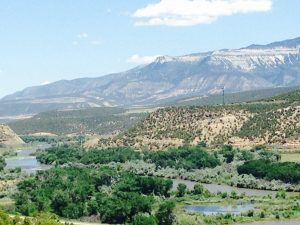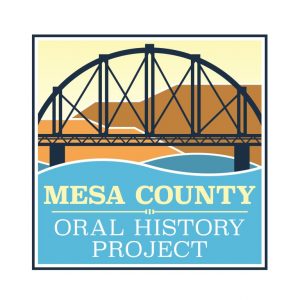Early Mesa County settler Zelma (Jones) Parkes collected over 200 kinds of barbed wire, could “witch for water,” and knew De Beque, Colorado like the back of her hand.

De Beque, the land where Zelma Parkes moved in 1939. Photo source: Colorado.gov
After her marriage to Elwood Parkes, they moved to a ranch on Clear Creek in 1939 and proceeded to dwell in De Beque for thirty one years. During her time living in the area, Zelma heard many stories of the town and its older pioneers. She was kind enough to share these stories during a wonderfully thorough and articulate interview with the Mesa County Oral History Project in August of 1978.
To make it to De Beque, Zelma recalled early settlers having a few options: one was to head directly to the area and if approaching from the south and take a ferry across the Colorado River. Back in day if a bridge didn’t exist, a ferry was a luxurious option to avoid swimming across. The second option was the take the train to Grand Junction, drive a team of horses north to Kimball Creek, turn right to make your way down to De Beque. This trip would be almost 70 miles. Apparently in the 1920’s, De Beque also featured a small airport. According to a 1928 article in the Aspen Daily Times, “De Beque will open its municipal airport Labor Day with a celebration, including a rodeo, a barbecue, horse races and dancing. Visitors from all over the state are expected to attend the opening.”
The town was rich in hunting during the early 1900’s. Zelma remembers hearing of a shortage of deer during around 1910, and the area being overran by Timber Wolves instead targeting farmer’s cattle for their dinner. The farmers began to retaliate against this nuisance by killing off the wolves – Zelma said she acquired the hide of the last known Timber Wolf and had it hanging on her wall. Zelma was no stranger to the animals roaming De Beque, and at times had to put on her brave face in canyon country. She recalled once hearing a puma wail out in the night and stated, “Once you hear a puma cry, you never forget it.”
At one point, Zelma had the privilege of rifling through some old, rare books on Deer Park (a specific area in De Beque that Zelma also refered to as Long Gulch) that mentioned hunters coming from all over the world to hunt deer, bears, and mountain lions in De Beque. A man named George Newton (the only county water commissioner to ever represent the Roan Creek area) used to take out hunting parties and allow them to stay at his lodge, charging as much as $100 per person. These parties sometimes included celebrities – Zelma stated that Theodore Roosevelt was rumored to have joined a hunting party, as well as a Scottish Lord. The story goes that at camp during a trip, the Scottish Lord asked for a clean plate for his apple pie at dinner. In gritty cowboy fashion, the camp cook took his plate, gave it to a dog to lick off, then handed it back. Welcome to the West!
Zelma had plenty more fascinating insider secrets of De Beque in her Mesa County Oral History Project interview. A final tidbit I’ll share with you involves an old tradition and technique for finding a water source referred to as “water witching,” “doodle-bugging,” or “dowsing.” Settlers in Mesa County, including Zelma, and all over the world claimed they could find a water source from anywhere they were standing. A water witcher holds a forked stick horizontally in front of them (Zelma says she uses one from a Boxelder Tree), and the stick will start to lead them, bending towards the ground the closer you get to the water source. When asked if she could really find water using this method, Zelma replied, “The stick is never quiet in my hands.”

